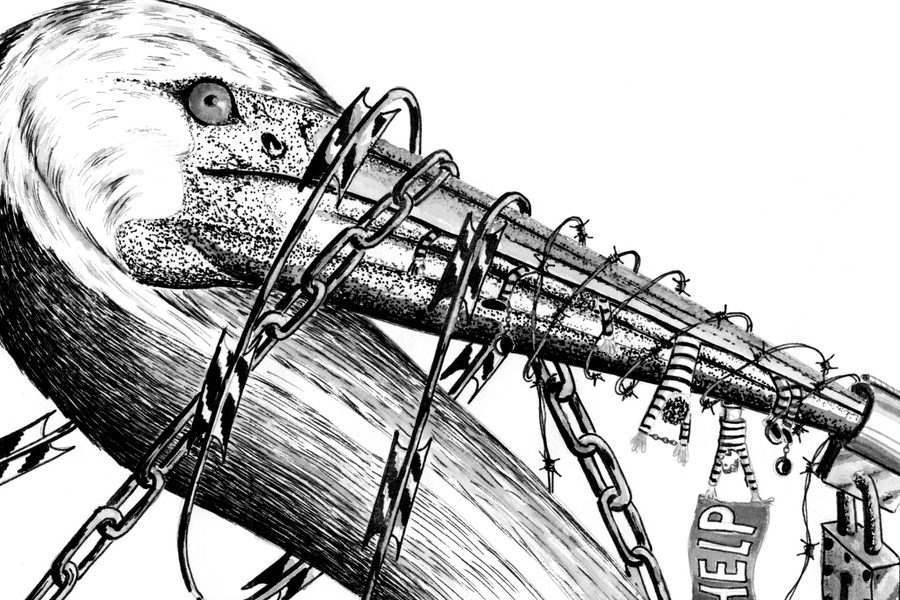
“If my sacrifice would change the conditions so that generations of prisoners behind me don’t have to suffer the 20-plus years that I’ve done, I can live with that,” says Sitawa Nantambu Jamaa, a prisoner in the Security Housing Unit (SHU) of California’s Pelican Bay State Prison. Jamaa was one of four Pelican Bay prisoners who put out a call in February for the third statewide hunger strike in two years to demand an end to long-term solitary confinement. On Thursday, the fourth day of the strike, corrections officials confirmed that almost 12,500 prisoners in 24 state prisons and four out-of-state facilities had missed nine consecutive meals (the threshold at which California’s Department of Corrections and Rehabilitation officially recognizes a strike).
The first two hunger strikes against solitary confinement, in 2011, resulted in minor changes in policy: Prisoners were provided with beanie hats, and promised pull-up bars in their exercise cages. They were also permitted to send a photo to their families once a year. (Before the policy change, the most recent photo Jamaa’s sister had of him was from 1988.) But prisoners say the Corrections Department has yet to seriously address their main demand: an end to the use of solitary confinement.
“They have made a decision that the change is so necessary that they have to make a sacrifice, and the only weapon that they have is to inflict pain on themselves,” says Jamaa’s younger sister, Marie Levin. “Because they don’t have any other recourse. There’s nothing else that they can use.”
U.S. District Court Judge Thelton Henderson ruled in 1995 that conditions in SHU “may press the outer bounds of what most humans can psychologically tolerate.” Without access to phone calls, testimony from prisoners about their experience in solitary confinement comes mostly from legal visits and letters. “I live in an 8×12 [foot] concrete cell by myself, I’m on 24-7 lockdown,” writes a Tehachapi SHU prisoner now participating in the hunger strike “I get yard once a week, which is a 10×15 steel cage outside all by myself for two hours.” His letter goes on: “The worst thing is the nothingness, the lack of purpose.” The prisoner’s family did not want his name used, out of concern for reprisals — the department is treating the hunger strike as “a mass disturbance” for which participating inmates face “disciplinary action.”
Since the first two hunger strikes, California’s Department of Corrections and Rehabilitation has begun reviewing the cases of all prisoners currently being held in solitary confinement, and has already released hundreds of inmates back into the general prison population. But the process will take time to complete — more than 3,000 people are held in SHU in California. Prisoners and their supporters have accused the department of acting in bad faith, and some family members, like Dolores Canales, whose son, John Martinez, has been in solitary for thirteen years, doubt the department’s commitment to change. Canales wonders if the department will address any of the prisoners’ core demands, “because they still continue to adamantly justify the use of solitary confinement.”
When she speaks to family members whose loved ones have been isolated for decades, Canales says, she wonders if that is the fate that awaits her family. “My son and the various prisoners talk about the feeling of disappearing into those walls,” she says. Along with other family members of SHU prisoners, Canales is co-founder of California Families to Abolish Solitary Confinement. “It’s just too painful and too hard to stay silent,” she says.
Canales, who is also on a hunger strike this week, says she believes that this time the prisoners will “hold out to the end, whatever that end might be.” In 2011, hundreds of prisoners went without food for a month before suspending their protest after receiving what they said were assurances from the department that key issues would be addressed. This time, “there’s a core group of us committed to taking this all the way to the death if necessary,” says Todd Ashker, another prisoner inside Pelican Bay State Prison. “None of us want to do this, but we feel like we have no other option.”
Terry Thornton, a spokesperson for the Department of Corrections, said it was too early to talk about how the department will respond if prisoners continue with the hunger strike, but she says that the department will not negotiate with prisoners. “To hold an entire system hostage like this, I don’t think it’s right,” says Thornton. “To engage in disruptive behavior is really inappropriate and we feel it’s an ineffective way to address their concerns.”
While Thornton is clear that the hunger strike will not help the prisoners’ cause, Carol Strickman, a staff attorney at Legal Services for Prisoners with Children, disagrees. “Public education, attempting to influence public opinion, to influence public policy, is a tried and true method by which we make change in this country,” she says. Strickman is one of the attorneys representing 10 named prisoners, including Jamaa, in a class-action civil rights case against the state that is challenging both the constitutionality of long-term solitary confinement and the process by which prisoners are sentenced to SHU. After the first hunger strike, the representatives decided “not to put all their eggs in one basket,” says Strickman. She sees the two approaches going hand-in-hand: “It’s a collaborative affair — the lawsuit helps the movement and the movement helps the lawsuit, and hopefully together we’re making progress toward greater human rights.” The next hearing in the case is scheduled for August.
According to a statement released by Jamaa and the three other prisoners who called for the hunger strike, the protest is “not only to improve our own conditions but [is] also an act of solidarity with all prisoners and oppressed people around the world.” The four main prisoner representatives encouraged “everyone to take action to support the strike,” adding that “if it was not for your support, we would have died in 2011.”
This weekend is Sitawa Jamaa’s 55th birthday. His sister, Marie Levin, plans to spend it with other family members and supporters at a rally outside Corcoran State Prison, where prisoners are also on hunger strike. “I want to see my brother home one day,” says Levin. “All the things that the Corrections Department has been able to get away are going to be exposed. A change is gonna come.”


